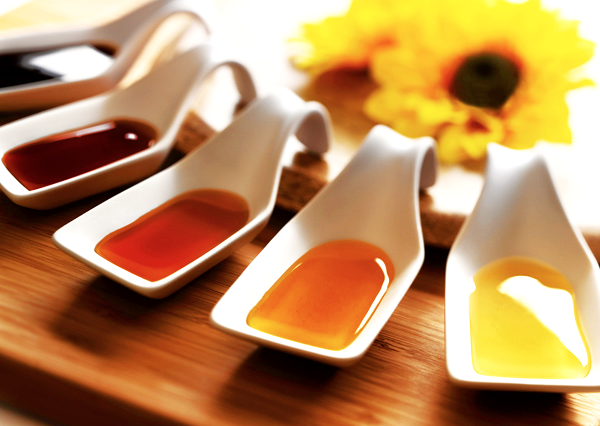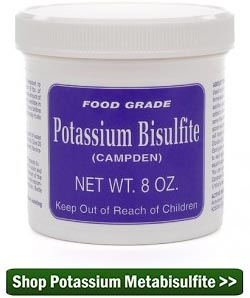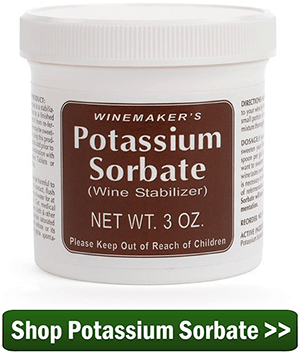 I’m getting ready to bottle a 12-gallon batch of California Connoisseur Pinot Noir. As always, everything went off without a hitch. I like my wine semi-dry, and would like to try sweetening with commercial store-bought honey this time, following the same Metabisulfite and Potassium Sorbate protocols for sugar. Any cautionary words of wisdom?
I’m getting ready to bottle a 12-gallon batch of California Connoisseur Pinot Noir. As always, everything went off without a hitch. I like my wine semi-dry, and would like to try sweetening with commercial store-bought honey this time, following the same Metabisulfite and Potassium Sorbate protocols for sugar. Any cautionary words of wisdom?
Name: Putnam J.
State: New York
—–
Hello Putnam,
I see that you’re up for a little adventure. You are correct in your assumption that potassium sorbate, potassium metabisulfite will need to be added to the wine kit at bottling time along with the honey. It’s no different than sweetening the wine with cane sugar or any other sugar that potentially provides food to the wine yeast.
All I can really say about sweetening a wine with honey is that you should take your time. Be sure-footed in what you do. You can always add more honey later to the wine, but taking it out is not an option. This is true for almost anything you add to a wine to adjust flavor.
For the most part, honey will sweeten the wine just as well as cane sugar. The sweet part is mostly the same. It’s the additional character that honey brings along with the sweet that makes it more adventurous. Depending on what the bees spun the honey off of — wildflowers, cherry blossoms, buckwheat, etc. —  the subtle notes and aromas added can vary from herbal, to fruity, to citrus. You may like it and consider it an improvement on the wine, but you may also decide you can’t stand it. Don’t assume that the honey will make the wine better. Try it out on a sample and see.
the subtle notes and aromas added can vary from herbal, to fruity, to citrus. You may like it and consider it an improvement on the wine, but you may also decide you can’t stand it. Don’t assume that the honey will make the wine better. Try it out on a sample and see.
Bench testing is the best way I know to sweeten a wine with honey. Take a measured sample of the wine, like a gallon or half-gallon, and start adding measured doses of the honey. Taste the wine between additions and see what you think. If you’re not sure, stop and come back to it another day.
If you decide that you don’t like what the honey’s done to the wine, switch back to cane sugar or something else. If you like the honey, but have added too much, blend the sample back in with the rest of the wine. Collect a new measured sample and start all over.
Once you establish a dosage, apply that dosage to the rest of the wine. This is the safest way I know to sweeten a wine with honey.
 Take your time. Sweetness is a major component of a wine’s flavor profile. For example, when I think I know what I want to do, I like to wait and come back later that day, or even the next day, and taste the wine again before moving forward.
Take your time. Sweetness is a major component of a wine’s flavor profile. For example, when I think I know what I want to do, I like to wait and come back later that day, or even the next day, and taste the wine again before moving forward.
Putnam, I hope this was the type of information you was looking for. It’s fun to play around with a wine, but it can also be a little nerve-racking at times. Hopefully, these little tips and insights on how to sweeten a wine with honey will keep you on a good path with your wine.
Happy Winemaking,
Ed Kraus
—–
Ed Kraus is a 3rd generation home brewer/winemaker and has been an owner of E. C. Kraus since 1999. He has been helping individuals make better wine and beer for over 25 years.

made some cherry and strawberry wine don’t really like either can I put the wine back in bucket and add store bought wine and bottle again
Margaret, there is nothing wrong with adding store-bought wine to homemade wine, however blending good wine with bad does not usually solve the problem. You are better off trying to figure out why you don’t like these wines then figure out what can be done to fix that defect. Here is an article on blending wines you might want to take a look at:
Blending To Improve Homemade Wines:
http://www.eckraus.com/wine-making-blending/
I have used agave nectar to back sweeten a few batches, and it works and tastes pretty much like Honey, but Agave Nectar is low on the glycemic index so will not affect blood sugar like sugar or honey. It is a good wine sweetener option for diabetics imho.
I have apple trees and I have bees. One of our favorite wines is what I call Happle wine. I sweeten my apple juice with honey to 13% potential. When it has quit working and ready to bottle, I use the taste test and adjust sweetness with cane sugar.
I am surprised that you do not give a hint on how much to add.
I would like to suggest adding 50 mls. to 23 lts ( 5 imperial gallons, 6 US gallons ). This will give you smoothness without detectable sweetness. 100 mls maybe detectable, and 160 mls.will make most wines like a Riesling, Gewurztraminer or a White Zinfandel
Thank you Don Bishop for the amounts with gallons.
Should agave nectar be added in the same amounts given for honey 50 to 100 milliliters?
Thanks very much and Happy New Year.
R. Lain
Richard, what we would recommend doing as with any type of sweetener is to take a measured amount of the wine and keep track of how much it took to get the the sweetness level you desire. Then you can just multiply that amount by the remainder of the batch. Doing it this way you can prevent over-sweetening the wine.
How do you actually add the honey?! Surely it needs to be warm to fully disperse? I have 5 gallons of undrinkable apple wine, 2½ years matured ( probably nearer 4 gallons now, as I will keep checking it’s still undrinkable!) I found adding ½tsp cane sugar, or 1tsp honey to the glass, made it much more palatable. (And I like a dry, but this is too tart!) Honey tasted better. Also found sediment in the bottles, so my thoughts are I’ll decant and filter the bottles back into a carboy, sweeten, then rebottle. Any thoughts? Also I have been wine making for 3 years or so now, this apple is my only failure, and I’ve never heard of (or used, obviously!) sodium bisulfite or potassium sorbate. But then I’ve never back sweetened. I have campden tablets, would they do instead?
Many thanks!
Kay, the campden tablets are what keep your wine from spoilage and they will not guarantee that a re-fermentation will not occur. Potassium sorbate is what you need to add to prevent re-fermentation when back-sweetening your wine.
To add a sweetener such as honey or a boiled sugar/ H20 ….when should it be added …after degassing and then before or after the clarifying agent and then 10 days or so before bottling?
Sylvia, sweetening wine should be done after the fermentation is complete, the wine is degassed, the wine has cleared and is ready to bottle.
So you are saying it should be added after all steps are complete except the bottling?
Dan, any type of sweetener added to back-sweeten the wine should be added after fermentation is complete the wine is clear and you have added potassium sorbate to prevent re-fermentation.
I have another question, I’m afraid! As my wine is already bottled, and therefore I need to decant and filter it, would it hurt to literally pour it through a filter paper back into the carboy along with 1 campden tablet per gallon? Or do I really need to syphon it to keep the air out? That would complicate the process no end!
Kay, you really never want to splash a finished wine in a way that allows air to saturate into it and that is what you would be doing. You do not want the wine to oxidize. It is more time consuming to siphon it.
I have bottled grapes from the vine from last year and after finishing both fermentations and left the wine to mature for 1 yr now find on tasting it’s what someone called tart whatever that means,can I uncork these bottles and change this wine??,..on the hydrometer b4 bottling it was dry wine at 12.5%,should I sweeten it
Sid, it could be that what you are tasting are the effects of a dry wine and sweetening might help. However, whenever you hear a wine is tart or sour it typically means the acid is too high. I would take a look at the article posted below for more information.
My Wine has A Sour Bitter Taste
https://blog.eckraus.com/homemade-wine-has-sour-bitter-taste
I have a question on sediment in my bottled wine. I made a cherry wine and once I put it in the carboy i racked it over every month for 7 months.I also degassed the wine. The wine was crystal clear so I filtered it with number 3 filters into my bottling bucket added ascorbic acid,sorbate and sweetened with sugar. One month later there is a fine sediment in the bottles! What could have caused this? Can I filter the wine after having sweetened it? Need help!! Thanks!
Did you use he boiled sugar / water mix if you just mixed in sugar I have found it to leave sediment.
When back sweetening with honey, you may want to let the honey particles settle before bottling, or filter the wine. I’ve used honey many times and it will leave settlings in your wine bottle if you bottle immediately after adding honey.
I have a dull 15 gallons of red 2 year wine that i would like to sweeten and add flavor using a grape concentrate containing preservatives. Is it necessary to add the required potassium sorbate of 1/2 tsp per gallon into the 15 gallon batch. Do i need to add any ptassium sorbate at all.
Rich, anytime you add sugar in any form to a finished wine for the purpose of sweetening the wine, we recommend adding potassium sorbate to prevent re-fermentation. There is no way to guarantee even if the juice contains preservatives that it will not start to ferment. It is better to be safe than sorry.
just wanted to know if you had any help for me on my sediment problem with my cherry wine? I posted on Dec 28th.
Hi I am making rhubarb wine normally use white sugar now I would like to use honey what is my best way to substitute honey for sugar.
Dale, As a general rule-of-thumb you can replace 1 pound of sugar with 1.2 to 1.3 pounds of honey. You can also use your hydrometer to help determine how much honey yo add. For more information on using honey instead of sugar to ferment, please see the article link below.
Using Honey Instead Of Sugar
https://blog.eckraus.com/using-honey-instead-of-sugar-in-wine-making
I’m making 5 gallons of muscadine wine for the first time and was consideried using honey to sweeten it. The flavor of honey to muscadine seems great together but, the honey separates in the liquid and looks like sludge in the bottom of a jar. Now I have stir/shake the mixture each time before drinking. Is this a common matter when using honey?
Joe, incorporating the honey into the wine is typically not a problem because honey blends very easily with wine, even at room temperature. If you wish, you can blend the honey in a gallon of the wine first, then blend that mix in with the entire batch of wine. What you are seeing could be the sediment from fermentation.